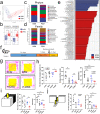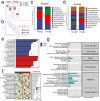Periodontitis salivary microbiota exacerbates colitis-induced anxiety-like behavior via gut microbiota
- PMID: 38062089
- PMCID: PMC10703887
- DOI: 10.1038/s41522-023-00462-9
Periodontitis salivary microbiota exacerbates colitis-induced anxiety-like behavior via gut microbiota
Abstract
The gut-brain axis is a bidirectional communication system between the gut and central nervous system. Many host-related factors can affect gut microbiota, including oral bacteria, making the brain a vulnerable target via the gut-brain axis. Saliva contains a large number of oral bacteria, and periodontitis, a common oral disease, can change the composition of salivary microbiota. However, the role and mechanism of periodontitis salivary microbiota (PSM) on the gut-brain axis remain unclear. Herein, we investigated the nature and mechanisms of this relationship using the mice with dextran sulfate sodium salt (DSS)-induced anxiety-like behavior. Compared with healthy salivary microbiota, PSM worsened anxiety-like behavior; it significantly reduced the number of normal neurons and activated microglia in DSS mice. Antibiotic treatment eliminated the effect of PSM on anxiety-like behavior, and transplantation of fecal microbiota from PSM-gavaged mice exacerbated anxiety-like behavior. These observations indicated that the anxiety-exacerbating effect of PSM was dependent on the gut microbiota. Moreover, the PSM effect on anxiety-like behavior was not present in non-DSS mice, indicating that DSS treatment was a prerequisite for PSM to exacerbate anxiety. Mechanistically, PSM altered the histidine metabolism in both gut and brain metabolomics. Supplementation of histidine-related metabolites had a similar anxiety-exacerbating effect as that of PSM, suggesting that histidine metabolism may be a critical pathway in this process. Our results demonstrate that PSM can exacerbate colitis-induced anxiety-like behavior by directly affecting the host gut microbiota, emphasizing the importance of oral diseases in the gut-brain axis.
© 2023. The Author(s).
Conflict of interest statement
The authors declare no competing interests.
Figures







Similar articles
-
Periodontitis Salivary Microbiota Worsens Colitis.J Dent Res. 2022 May;101(5):559-568. doi: 10.1177/00220345211049781. Epub 2021 Nov 19. J Dent Res. 2022. PMID: 34796773
-
Estrogen receptor β deficiency impairs gut microbiota: a possible mechanism of IBD-induced anxiety-like behavior.Microbiome. 2022 Sep 29;10(1):160. doi: 10.1186/s40168-022-01356-2. Microbiome. 2022. PMID: 36175956 Free PMC article.
-
A murine model of pediatric inflammatory bowel disease causes microbiota-gut-brain axis deficits in adulthood.Am J Physiol Gastrointest Liver Physiol. 2020 Sep 1;319(3):G361-G374. doi: 10.1152/ajpgi.00177.2020. Epub 2020 Jul 29. Am J Physiol Gastrointest Liver Physiol. 2020. PMID: 32726162 Free PMC article.
-
Exploring the oral-gut linkage: Interrelationship between oral and systemic diseases.Mucosal Immunol. 2024 Feb;17(1):147-153. doi: 10.1016/j.mucimm.2023.11.006. Epub 2023 Nov 24. Mucosal Immunol. 2024. PMID: 38007003 Free PMC article. Review.
-
Enduring sex-dependent implications of pubertal stress on the gut-brain axis and mental health.Front Behav Neurosci. 2024 Jan 11;17:1285475. doi: 10.3389/fnbeh.2023.1285475. eCollection 2023. Front Behav Neurosci. 2024. PMID: 38274549 Free PMC article. Review.
Cited by
-
Effect of perioperative probiotic intervention on postoperative cognitive dysfunction in elderly patients: a randomized double- blinded and placebo-controlled trial.J Transl Med. 2025 Jun 10;23(1):637. doi: 10.1186/s12967-025-06584-2. J Transl Med. 2025. PMID: 40495208 Free PMC article. Clinical Trial.
-
Hypoglycemic effect of peony flowers polyphenols based on gut microbiota and metabolomics.Front Nutr. 2025 Jun 2;12:1573865. doi: 10.3389/fnut.2025.1573865. eCollection 2025. Front Nutr. 2025. PMID: 40525132 Free PMC article.
-
Characteristics of Oral-Gut Microbiota in Model Rats with CUMS-Induced Depression.Neuropsychiatr Dis Treat. 2024 Feb 5;20:221-232. doi: 10.2147/NDT.S448940. eCollection 2024. Neuropsychiatr Dis Treat. 2024. PMID: 38344423 Free PMC article.
-
Ligature-induced periodontitis in a transgenic mouse model of Alzheimer's disease dysregulates neuroinflammation, exacerbates cognitive impairment, and accelerates amyloid pathology.Brain Behav Immun Health. 2025 Feb 25;44:100969. doi: 10.1016/j.bbih.2025.100969. eCollection 2025 Mar. Brain Behav Immun Health. 2025. PMID: 40094122 Free PMC article.
-
Association between oral dysbiosis and Parkinson's disease: a systematic review.Front Cell Infect Microbiol. 2025 May 13;15:1564362. doi: 10.3389/fcimb.2025.1564362. eCollection 2025. Front Cell Infect Microbiol. 2025. PMID: 40433667 Free PMC article.
References
MeSH terms
Substances
LinkOut - more resources
Full Text Sources
Molecular Biology Databases
Miscellaneous

